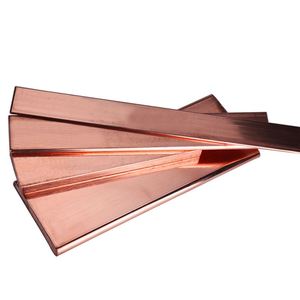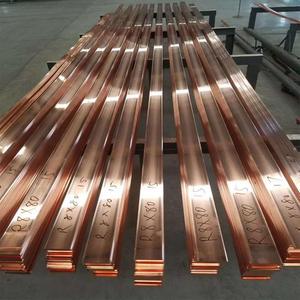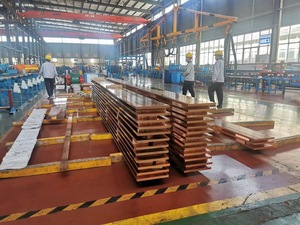
All categories
Featured selections
Trade Assurance
Buyer Central
Help Center
Get the app
Become a supplier

(4306 products available)




















The flexible copper busbar is a popular choice for supplying electrical energy in many systems, as it allows for easy installation. Busbars come in several configurations, including copper-carrying insulated bus bars, laminated insulated bus bars, and non-insulated bus bars. Each type differs in electrical and mechanical properties and which applications it best serves.
This is a common type in electrical systems. The simple, flat shape makes it easy to install, and it offers good conductivity for carrying large currents.
The flexible copper bar is designed with flexibility in mind. This makes it much easier to install in tight or complex spaces, where rigid bus bars simply won't fit.
A laminated busbar consists of several layers of metal insulated by thin, bonded layers of non-conductive material. This design allows for excellent conductivity while also providing the flexibility needed for installation in different types of equipment.
A sheet copper busbar is manufactured from a flat sheet of copper cut to the desired shape and size. It offers good rigidity and is suitable for environments where a strong, stable power distribution is needed.
As the name suggests, a stranded copper busbar is made up of multiple strands of copper wire. This construction allows for high flexibility, unlike its solid counterparts.
Electrical equipment requires copper busbars due to their high flexibility and conductivity. The busbars act as a bridge to distribute electric current to different components of the system. Some key areas where copper busbars are indispensable to the smooth running of the operation include:
Flexible copper busbars are used in power plants and electrical grids to transfer large amounts of current. Their flexibility makes them ideal for connecting generators, transformers, and switchgear in complex arrangements.
Data centers need lots of power to operate all the servers and cooling systems. Flexible copper busbars distribute this power around the facility reliably and efficiently. Their flexibility also helps fit the busbars into the center's tight and changing layouts.
Flexible copper busbars provide power to heavy machinery, equipment, and tools. Because many manufacturing plants have large machines that require a lot of power, the busbars help deliver this power where it is needed. The busbars' flexibility is helpful as the plants often have to change the layout depending on production needs.
Subways, trains, and electric vehicle charging stations require many electric components. Flexible copper busbars connect these components and provide the power needed for operational stability. The busbars' flexibility makes them suitable for the various configurations of these complex systems.
Busbars are essential components in solar and wind energy systems, connecting solar panels, inverters, and batteries, especially under unpredictable energy conditions. Flexible copper busbars make it easier to install these systems, particularly when dealing with the large, complex arrays often used in industrial-scale power generation.
High electrical conductivity
Copper is one of the best conductors of electricity, second only to silver. Flexible copper busbars are designed to handle large electrical currents with minimal energy loss. This makes them ideal for power-hungry applications like manufacturing, data centers, and renewable energy systems.
Highly flexible
The flexibility of copper busbars makes them suitable for complicated or tight spaces during installation. They can bend and conform to different shapes and layouts, in contrast to rigid bus bars. This characteristic makes them a practical alternative for diverse applications where the configuration may need to be adjusted or where there may be limited area.
Durable construction
Busbars are built to stand up to wear and tear as well as extreme temperatures. They will not easily break or crack under stress, which is essential for applications that require heavy power loads.
Corrosion resistance
Copper is highly resistant to corrosion. Flexible copper busbars are able to maintain their conductivity over extended periods, unlike other materials that may degrade over time with exposure to moisture or chemical elements.
Compact design
Busbars offer a condensed and dense path for electric current. Their slim profile allows for easier installation in areas with space constraints, which is especially common in modern electrical systems.
Assess the area
The first step is to examine the region where the busbar will be installed. Consider all space constraints, including the flexible busbar's layout and configuration.
Prepare components
Gather the flexible copper busbar and all necessary connectors, mounting hardware, and insulation. Ensure everything is ready for the installation process before beginning.
Turn off power
Always disconnect the electrical system from the power source before beginning work. This guarantees safety while preventing potential damage to the equipment.
Install insulating layers (if needed)
If the application necessitates insulating layers, such as busbars used in circumstances where they may contact with non-conductive components, install the insulating pieces first. Position them according to space requirements.
Attach busbar to the frame
Place the flexible copper busbar into the space and attach it to the equipment using the mounting brackets or screws. Ensure the busbar is securely held in place.
Connect components
Next, connect the busbar to different electrical components like batteries, switches, or motors. Use the appropriate connectors for a sturdy and solid electrical connection.
Secure connections properly
Make sure that all connections are tightened down properly. Loose connections can result in less power supply or possibly fire hazards.
Double-check everything
Take a step back and evaluate the whole installation process. Confirm that the busbar is mounted securely and all connections are proper and tight before switching the power on.
In industrial settings, many machines are interconnected and share power or data through copper busbars. In such systems, busbars provide a centralized location for distributing electricity where it is needed most. Therefore, maintenance is critical to ensure there are no system downtimes due to malfunctioning busbars.
Regular inspections
Visual inspections should be done on a regular basis. It is important to look for any signs of wear, corrosion, or damage.
Keep it clean
Keep the flexible copper busbars free of dust, grime, and grease to prevent poor conductivity. Use a non-abrasive cleaner that will not damage the copper surface.
Check for loose connections
Regularly check that all wiring connections to the busbar are firm and secure, as loose connections can cause heat buildup and system failure.
Monitor for heat
Excessive heat is an indication that the busbar is overloaded. Keeping an eye on this means never giving the bar more load than it can carry.
Inspect insulation
If the busbar has any insulating coverings, look them over for cracks, peeling, or deterioration. Damaged insulation could cause short circuits or electrical shocks.
Periodic testing
Using a multimeter or other electrical testing device, check the busbar for resistivity. If the busbar shows high resistivity, it might be time to replace it since this is a signal that it is no longer in good working condition.
Schedule replacements
Plan on replacing flexible copper busbars after a certain period based on wear and tear, or signs of failing conductivity.
There are several different flexible copper busbar types, and each is different in how it conducts electric current, mechanically holds up, and which application it is best for. A buyer's decision on which type to buy should be based on the purpose the busbar will serve and the demands of the environment in which it will be used.
Dimensional specifications and load rating
Flexible busbars are made in many shapes and sizes, from standard rectangular busbars to thinner sheet or highly flexible laminated and stranded types. Larger busbars possess the ability to carry more current. Take into consideration the amount of electrical current the busbar will need to handle in its application. Ensure that the busbar is sized correctly for its power distribution task.
Insulation requirements
Insulation is present on some flexible copper busbars but absent on others. Busbars with insulation are for use in applications where the busbar could come into contact with non-conductive components or where there is a risk of electric shock. Conversely, non-insulated busbars are more suitable in environments where there is direct connection to the conductors, as they have better conductivity.
Thermal management
Successful heat dissipation is key to the effective operation of flexible copper busbars since they may have to deal with large currents that can raise their temperature. Some busbars come with added cooling features or are constructed to better dissipate heat. Consider this when selecting a busbar for purposes where overheating is a concern.
Failure history
Examine the track record of manufacturers for creating reliable and high-performance busbar systems. Look for reviews or testimonials from other users to determine which manufacturers have produced busbars that can stand the test of time in real-world scenarios.
Customization options
Many busbars are customized to better fit specific applications. Manufacturers can tailor the busbar in terms of size, shape, or number of conductive elements to suit the client's needs. Buying from a producer that provides such customization helps ensure the busbar constructed is the best fit possible for the intended application.
Material quality
Ask the supplier what type of copper they use to make their busbars. Find out if it is oxygen-free copper or high-purity copper for optimal conductivity. The quality of the materials affects the busbar's ability to carry current and resist heat buildup.
Manufacturing processes
Inquire about how the busbars are manufactured. Processes such as laminating or stranding add to their flexibility. It helps to understand the production methods in order to assess how flexible the busbars will be for installation purposes.
Customization capabilities
Find out whether the supplier provides customized solutions. Manufacturers may tailor the busbar system to meet specific power requirements or dimensional constraints. Buying a custom busbar makes it a better fit for the particular application.
Certification and standards
Ensure that the busbar complies with relevant electrical codes and industry standards. This guarantees performance and safety. Ask about any certifications that apply to their materials or manufacturing processes.
Testing and quality assurance
Inquire about any quality control measures taken by the supplier. Find out more about the testing procedures materials go through to verify that the busbars are robust and will perform well under great electric current. Suppliers who publicly proclaim quality assurance often have better products.
Product range
Check to see the different types of busbars the supplier provides. Suppliers offer insulated, non-insulated, and flexible copper busbars made from different thicknesses of copper in various shapes and sizes that are suitable for different applications. Choosing a reputable supplier ensures they have a wide range of products helps find one that is right for power distribution needs.
A1. Copper busbars generally have more conductivity than aluminum busbars. This enables they to carry more current. Copper is also denser than aluminum, which allows for a smaller profile in tighter spaces. As a result, flexible copper busbars are ideal in complex industrial systems that need efficient power distribution.
A2. Busbars demand simple but frequent upkeep to maximize power delivery. Their surfaces should always be kept clean and free of dust or residue. Regular inspections enable discovery and fixing of potential issues like corrosion or heat damage. Further, ensure all electrical connections remain snug, as loose connections decrease efficiency and pose fire hazards in industrial settings.
A3. Manufacturers fabricate flexible copper busbars using unique methods like stranding or lamination. These methods create busbars with great flexibility to accommodate tight spaces or complex configurations during installation. Flexibility is vital in industries with restricted areas to allow efficient power distribution.
A4. Flexible copper busbars feature thermal dissipation designs and heat sinks that help spread the heat generated by electric current throughout the busbar system. The large amounts of copper used in the barwork area also help absorb and transfer heat from the conductors to the surroundings.
A5. Copper busbars should not be allowed to carry more current than their design capacity. Adequate ventilation further prevents heat accumulation. Insulations on the busbars should not be damaged, as this could also cause overheating. Regular monitoring of temperature changes will enable identification of any overheating problems so corrective action can be done early.